Project Management Report: Agile, Waterfall, and HR Aspects
VerifiedAdded on 2022/08/02
|8
|1382
|17
Report
AI Summary
This report analyzes various aspects of project management, including project execution, managing disruptions, and human resource management. The first part of the report presents a case study on revamping an online billing system, detailing the project scope, timeline, and challenges faced. It covers the project plan, the identification of critical tasks, and the implementation of solutions to manage delays. The report then explores managing disruptions, using a case study on developing new billing software, highlighting the shift from waterfall to agile methodology to accommodate changing client requirements. It also discusses managing HR aspects, showcasing how project managers can use legitimate and expert power to secure necessary resources and influence stakeholders. The report further examines project procurement, detailing the process of selecting a third-party vendor for website development, and emphasizes the importance of make-or-buy analysis, statement of work, and contract management. Finally, the report compares agile and waterfall methodologies, providing scenarios where each approach is best suited, such as software development (agile) and projects with specific requirements (waterfall).
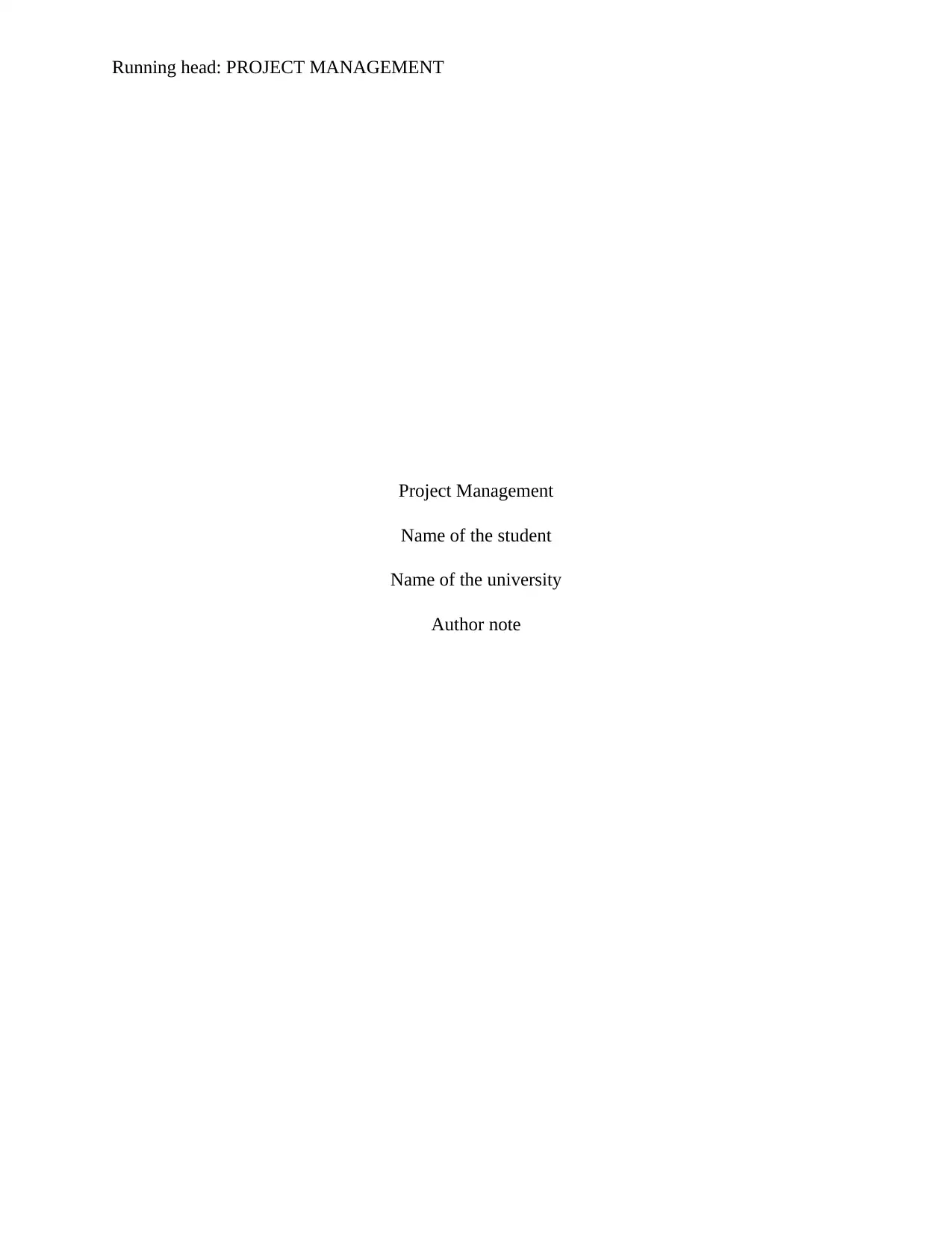
Running head: PROJECT MANAGEMENT
Project Management
Name of the student
Name of the university
Author note
Project Management
Name of the student
Name of the university
Author note
Paraphrase This Document
Need a fresh take? Get an instant paraphrase of this document with our AI Paraphraser
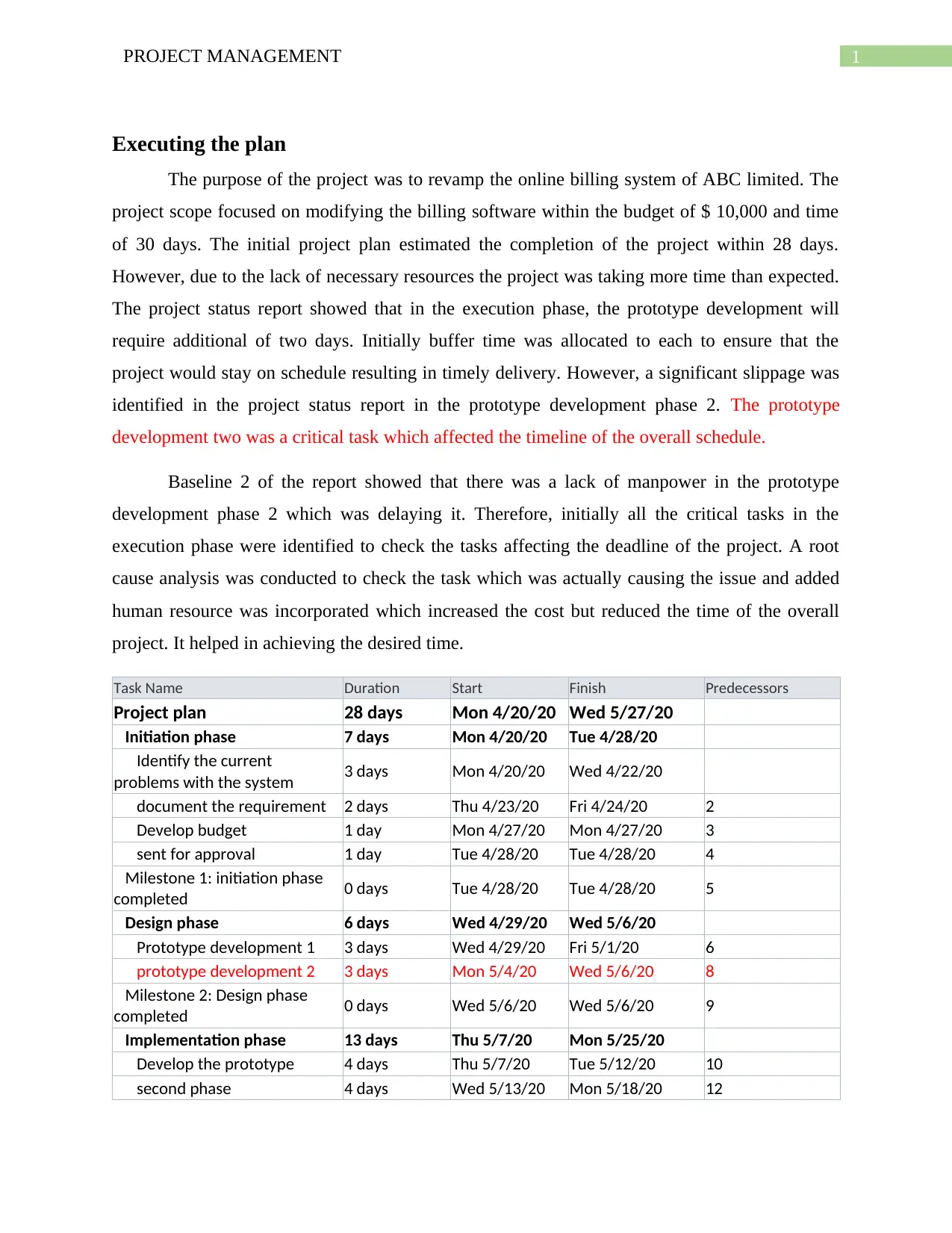
1PROJECT MANAGEMENT
Executing the plan
The purpose of the project was to revamp the online billing system of ABC limited. The
project scope focused on modifying the billing software within the budget of $ 10,000 and time
of 30 days. The initial project plan estimated the completion of the project within 28 days.
However, due to the lack of necessary resources the project was taking more time than expected.
The project status report showed that in the execution phase, the prototype development will
require additional of two days. Initially buffer time was allocated to each to ensure that the
project would stay on schedule resulting in timely delivery. However, a significant slippage was
identified in the project status report in the prototype development phase 2. The prototype
development two was a critical task which affected the timeline of the overall schedule.
Baseline 2 of the report showed that there was a lack of manpower in the prototype
development phase 2 which was delaying it. Therefore, initially all the critical tasks in the
execution phase were identified to check the tasks affecting the deadline of the project. A root
cause analysis was conducted to check the task which was actually causing the issue and added
human resource was incorporated which increased the cost but reduced the time of the overall
project. It helped in achieving the desired time.
Task Name Duration Start Finish Predecessors
Project plan 28 days Mon 4/20/20 Wed 5/27/20
Initiation phase 7 days Mon 4/20/20 Tue 4/28/20
Identify the current
problems with the system 3 days Mon 4/20/20 Wed 4/22/20
document the requirement 2 days Thu 4/23/20 Fri 4/24/20 2
Develop budget 1 day Mon 4/27/20 Mon 4/27/20 3
sent for approval 1 day Tue 4/28/20 Tue 4/28/20 4
Milestone 1: initiation phase
completed 0 days Tue 4/28/20 Tue 4/28/20 5
Design phase 6 days Wed 4/29/20 Wed 5/6/20
Prototype development 1 3 days Wed 4/29/20 Fri 5/1/20 6
prototype development 2 3 days Mon 5/4/20 Wed 5/6/20 8
Milestone 2: Design phase
completed 0 days Wed 5/6/20 Wed 5/6/20 9
Implementation phase 13 days Thu 5/7/20 Mon 5/25/20
Develop the prototype 4 days Thu 5/7/20 Tue 5/12/20 10
second phase 4 days Wed 5/13/20 Mon 5/18/20 12
Executing the plan
The purpose of the project was to revamp the online billing system of ABC limited. The
project scope focused on modifying the billing software within the budget of $ 10,000 and time
of 30 days. The initial project plan estimated the completion of the project within 28 days.
However, due to the lack of necessary resources the project was taking more time than expected.
The project status report showed that in the execution phase, the prototype development will
require additional of two days. Initially buffer time was allocated to each to ensure that the
project would stay on schedule resulting in timely delivery. However, a significant slippage was
identified in the project status report in the prototype development phase 2. The prototype
development two was a critical task which affected the timeline of the overall schedule.
Baseline 2 of the report showed that there was a lack of manpower in the prototype
development phase 2 which was delaying it. Therefore, initially all the critical tasks in the
execution phase were identified to check the tasks affecting the deadline of the project. A root
cause analysis was conducted to check the task which was actually causing the issue and added
human resource was incorporated which increased the cost but reduced the time of the overall
project. It helped in achieving the desired time.
Task Name Duration Start Finish Predecessors
Project plan 28 days Mon 4/20/20 Wed 5/27/20
Initiation phase 7 days Mon 4/20/20 Tue 4/28/20
Identify the current
problems with the system 3 days Mon 4/20/20 Wed 4/22/20
document the requirement 2 days Thu 4/23/20 Fri 4/24/20 2
Develop budget 1 day Mon 4/27/20 Mon 4/27/20 3
sent for approval 1 day Tue 4/28/20 Tue 4/28/20 4
Milestone 1: initiation phase
completed 0 days Tue 4/28/20 Tue 4/28/20 5
Design phase 6 days Wed 4/29/20 Wed 5/6/20
Prototype development 1 3 days Wed 4/29/20 Fri 5/1/20 6
prototype development 2 3 days Mon 5/4/20 Wed 5/6/20 8
Milestone 2: Design phase
completed 0 days Wed 5/6/20 Wed 5/6/20 9
Implementation phase 13 days Thu 5/7/20 Mon 5/25/20
Develop the prototype 4 days Thu 5/7/20 Tue 5/12/20 10
second phase 4 days Wed 5/13/20 Mon 5/18/20 12
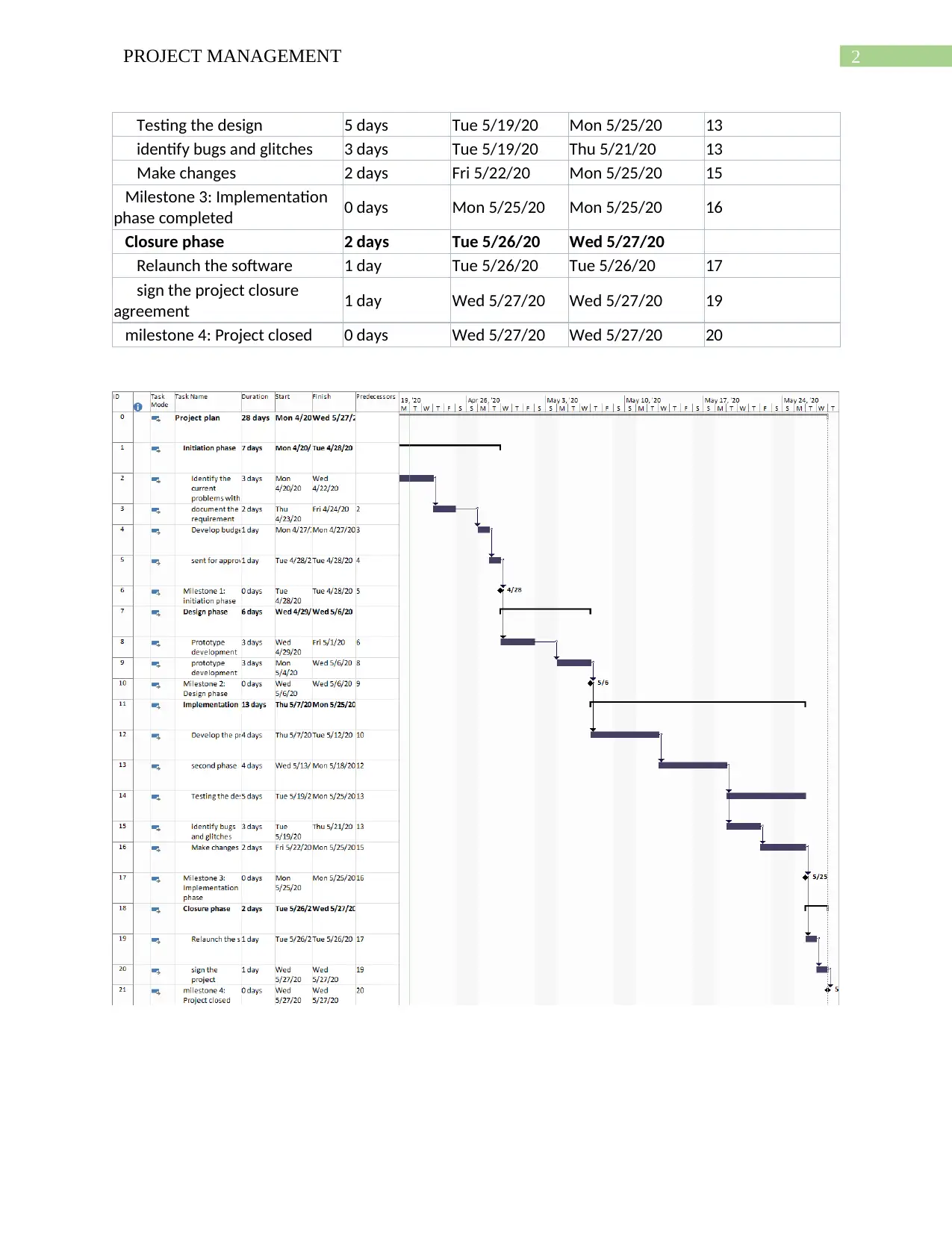
2PROJECT MANAGEMENT
Testing the design 5 days Tue 5/19/20 Mon 5/25/20 13
identify bugs and glitches 3 days Tue 5/19/20 Thu 5/21/20 13
Make changes 2 days Fri 5/22/20 Mon 5/25/20 15
Milestone 3: Implementation
phase completed 0 days Mon 5/25/20 Mon 5/25/20 16
Closure phase 2 days Tue 5/26/20 Wed 5/27/20
Relaunch the software 1 day Tue 5/26/20 Tue 5/26/20 17
sign the project closure
agreement 1 day Wed 5/27/20 Wed 5/27/20 19
milestone 4: Project closed 0 days Wed 5/27/20 Wed 5/27/20 20
Testing the design 5 days Tue 5/19/20 Mon 5/25/20 13
identify bugs and glitches 3 days Tue 5/19/20 Thu 5/21/20 13
Make changes 2 days Fri 5/22/20 Mon 5/25/20 15
Milestone 3: Implementation
phase completed 0 days Mon 5/25/20 Mon 5/25/20 16
Closure phase 2 days Tue 5/26/20 Wed 5/27/20
Relaunch the software 1 day Tue 5/26/20 Tue 5/26/20 17
sign the project closure
agreement 1 day Wed 5/27/20 Wed 5/27/20 19
milestone 4: Project closed 0 days Wed 5/27/20 Wed 5/27/20 20
⊘ This is a preview!⊘
Do you want full access?
Subscribe today to unlock all pages.

Trusted by 1+ million students worldwide
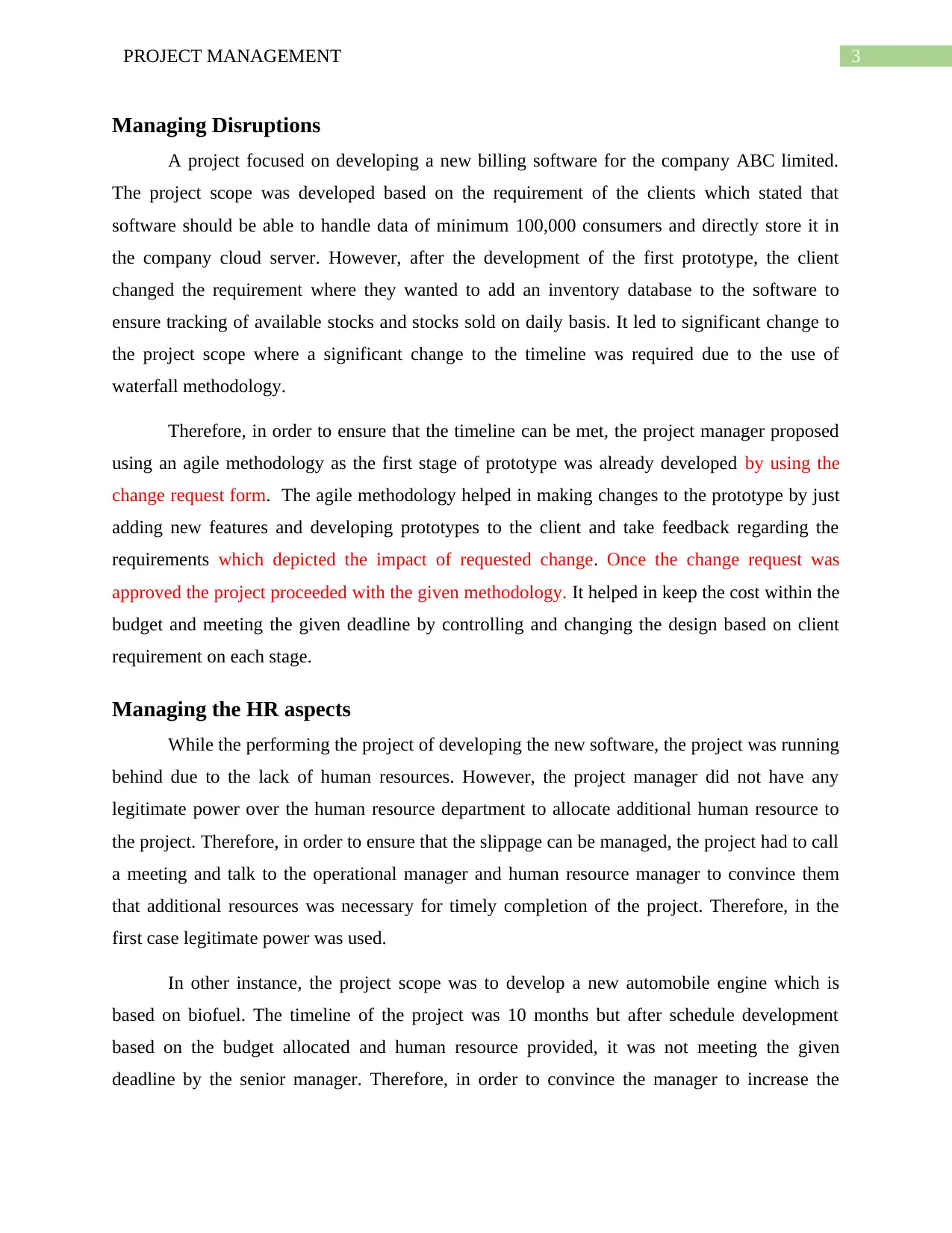
3PROJECT MANAGEMENT
Managing Disruptions
A project focused on developing a new billing software for the company ABC limited.
The project scope was developed based on the requirement of the clients which stated that
software should be able to handle data of minimum 100,000 consumers and directly store it in
the company cloud server. However, after the development of the first prototype, the client
changed the requirement where they wanted to add an inventory database to the software to
ensure tracking of available stocks and stocks sold on daily basis. It led to significant change to
the project scope where a significant change to the timeline was required due to the use of
waterfall methodology.
Therefore, in order to ensure that the timeline can be met, the project manager proposed
using an agile methodology as the first stage of prototype was already developed by using the
change request form. The agile methodology helped in making changes to the prototype by just
adding new features and developing prototypes to the client and take feedback regarding the
requirements which depicted the impact of requested change. Once the change request was
approved the project proceeded with the given methodology. It helped in keep the cost within the
budget and meeting the given deadline by controlling and changing the design based on client
requirement on each stage.
Managing the HR aspects
While the performing the project of developing the new software, the project was running
behind due to the lack of human resources. However, the project manager did not have any
legitimate power over the human resource department to allocate additional human resource to
the project. Therefore, in order to ensure that the slippage can be managed, the project had to call
a meeting and talk to the operational manager and human resource manager to convince them
that additional resources was necessary for timely completion of the project. Therefore, in the
first case legitimate power was used.
In other instance, the project scope was to develop a new automobile engine which is
based on biofuel. The timeline of the project was 10 months but after schedule development
based on the budget allocated and human resource provided, it was not meeting the given
deadline by the senior manager. Therefore, in order to convince the manager to increase the
Managing Disruptions
A project focused on developing a new billing software for the company ABC limited.
The project scope was developed based on the requirement of the clients which stated that
software should be able to handle data of minimum 100,000 consumers and directly store it in
the company cloud server. However, after the development of the first prototype, the client
changed the requirement where they wanted to add an inventory database to the software to
ensure tracking of available stocks and stocks sold on daily basis. It led to significant change to
the project scope where a significant change to the timeline was required due to the use of
waterfall methodology.
Therefore, in order to ensure that the timeline can be met, the project manager proposed
using an agile methodology as the first stage of prototype was already developed by using the
change request form. The agile methodology helped in making changes to the prototype by just
adding new features and developing prototypes to the client and take feedback regarding the
requirements which depicted the impact of requested change. Once the change request was
approved the project proceeded with the given methodology. It helped in keep the cost within the
budget and meeting the given deadline by controlling and changing the design based on client
requirement on each stage.
Managing the HR aspects
While the performing the project of developing the new software, the project was running
behind due to the lack of human resources. However, the project manager did not have any
legitimate power over the human resource department to allocate additional human resource to
the project. Therefore, in order to ensure that the slippage can be managed, the project had to call
a meeting and talk to the operational manager and human resource manager to convince them
that additional resources was necessary for timely completion of the project. Therefore, in the
first case legitimate power was used.
In other instance, the project scope was to develop a new automobile engine which is
based on biofuel. The timeline of the project was 10 months but after schedule development
based on the budget allocated and human resource provided, it was not meeting the given
deadline by the senior manager. Therefore, in order to convince the manager to increase the
Paraphrase This Document
Need a fresh take? Get an instant paraphrase of this document with our AI Paraphraser
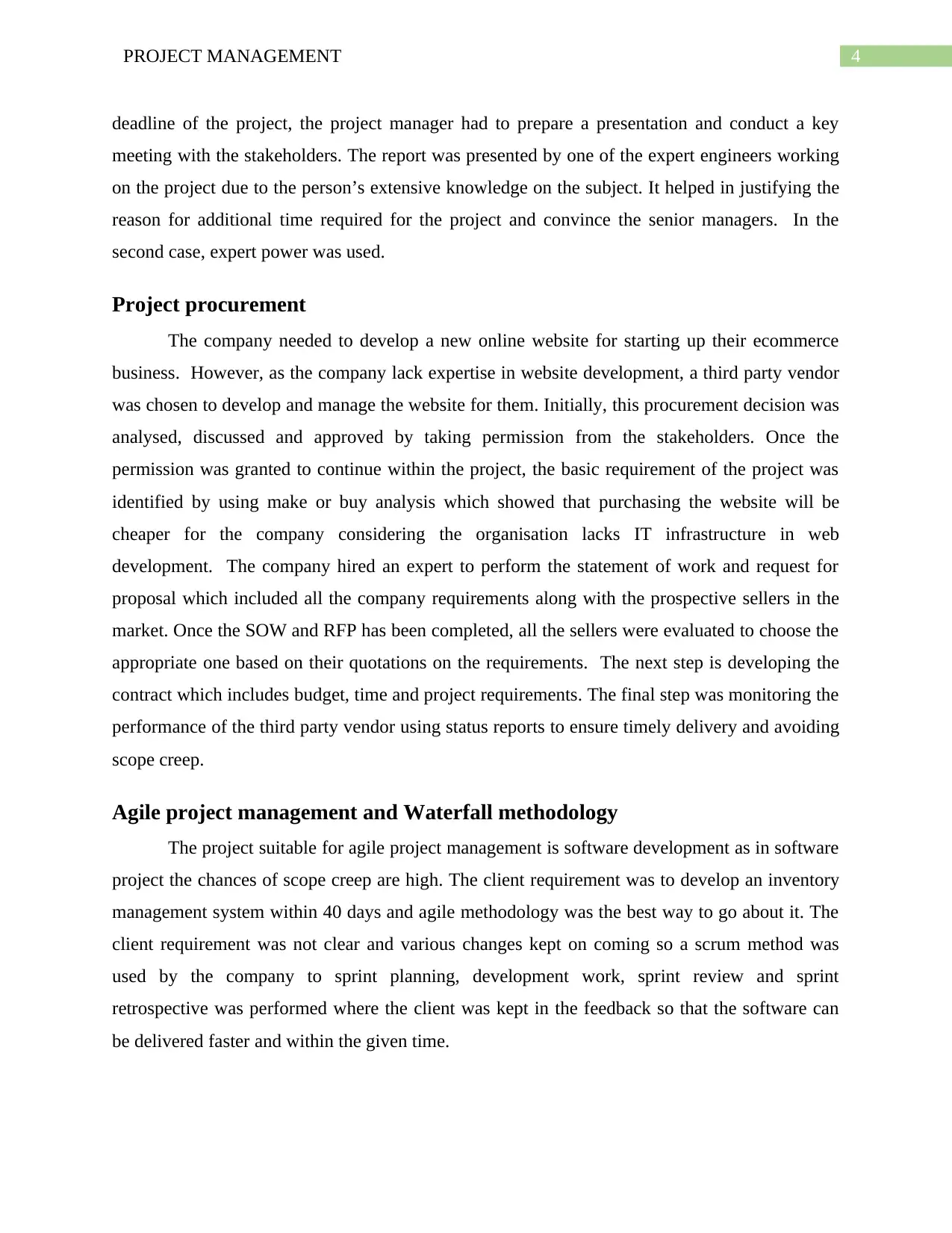
4PROJECT MANAGEMENT
deadline of the project, the project manager had to prepare a presentation and conduct a key
meeting with the stakeholders. The report was presented by one of the expert engineers working
on the project due to the person’s extensive knowledge on the subject. It helped in justifying the
reason for additional time required for the project and convince the senior managers. In the
second case, expert power was used.
Project procurement
The company needed to develop a new online website for starting up their ecommerce
business. However, as the company lack expertise in website development, a third party vendor
was chosen to develop and manage the website for them. Initially, this procurement decision was
analysed, discussed and approved by taking permission from the stakeholders. Once the
permission was granted to continue within the project, the basic requirement of the project was
identified by using make or buy analysis which showed that purchasing the website will be
cheaper for the company considering the organisation lacks IT infrastructure in web
development. The company hired an expert to perform the statement of work and request for
proposal which included all the company requirements along with the prospective sellers in the
market. Once the SOW and RFP has been completed, all the sellers were evaluated to choose the
appropriate one based on their quotations on the requirements. The next step is developing the
contract which includes budget, time and project requirements. The final step was monitoring the
performance of the third party vendor using status reports to ensure timely delivery and avoiding
scope creep.
Agile project management and Waterfall methodology
The project suitable for agile project management is software development as in software
project the chances of scope creep are high. The client requirement was to develop an inventory
management system within 40 days and agile methodology was the best way to go about it. The
client requirement was not clear and various changes kept on coming so a scrum method was
used by the company to sprint planning, development work, sprint review and sprint
retrospective was performed where the client was kept in the feedback so that the software can
be delivered faster and within the given time.
deadline of the project, the project manager had to prepare a presentation and conduct a key
meeting with the stakeholders. The report was presented by one of the expert engineers working
on the project due to the person’s extensive knowledge on the subject. It helped in justifying the
reason for additional time required for the project and convince the senior managers. In the
second case, expert power was used.
Project procurement
The company needed to develop a new online website for starting up their ecommerce
business. However, as the company lack expertise in website development, a third party vendor
was chosen to develop and manage the website for them. Initially, this procurement decision was
analysed, discussed and approved by taking permission from the stakeholders. Once the
permission was granted to continue within the project, the basic requirement of the project was
identified by using make or buy analysis which showed that purchasing the website will be
cheaper for the company considering the organisation lacks IT infrastructure in web
development. The company hired an expert to perform the statement of work and request for
proposal which included all the company requirements along with the prospective sellers in the
market. Once the SOW and RFP has been completed, all the sellers were evaluated to choose the
appropriate one based on their quotations on the requirements. The next step is developing the
contract which includes budget, time and project requirements. The final step was monitoring the
performance of the third party vendor using status reports to ensure timely delivery and avoiding
scope creep.
Agile project management and Waterfall methodology
The project suitable for agile project management is software development as in software
project the chances of scope creep are high. The client requirement was to develop an inventory
management system within 40 days and agile methodology was the best way to go about it. The
client requirement was not clear and various changes kept on coming so a scrum method was
used by the company to sprint planning, development work, sprint review and sprint
retrospective was performed where the client was kept in the feedback so that the software can
be delivered faster and within the given time.
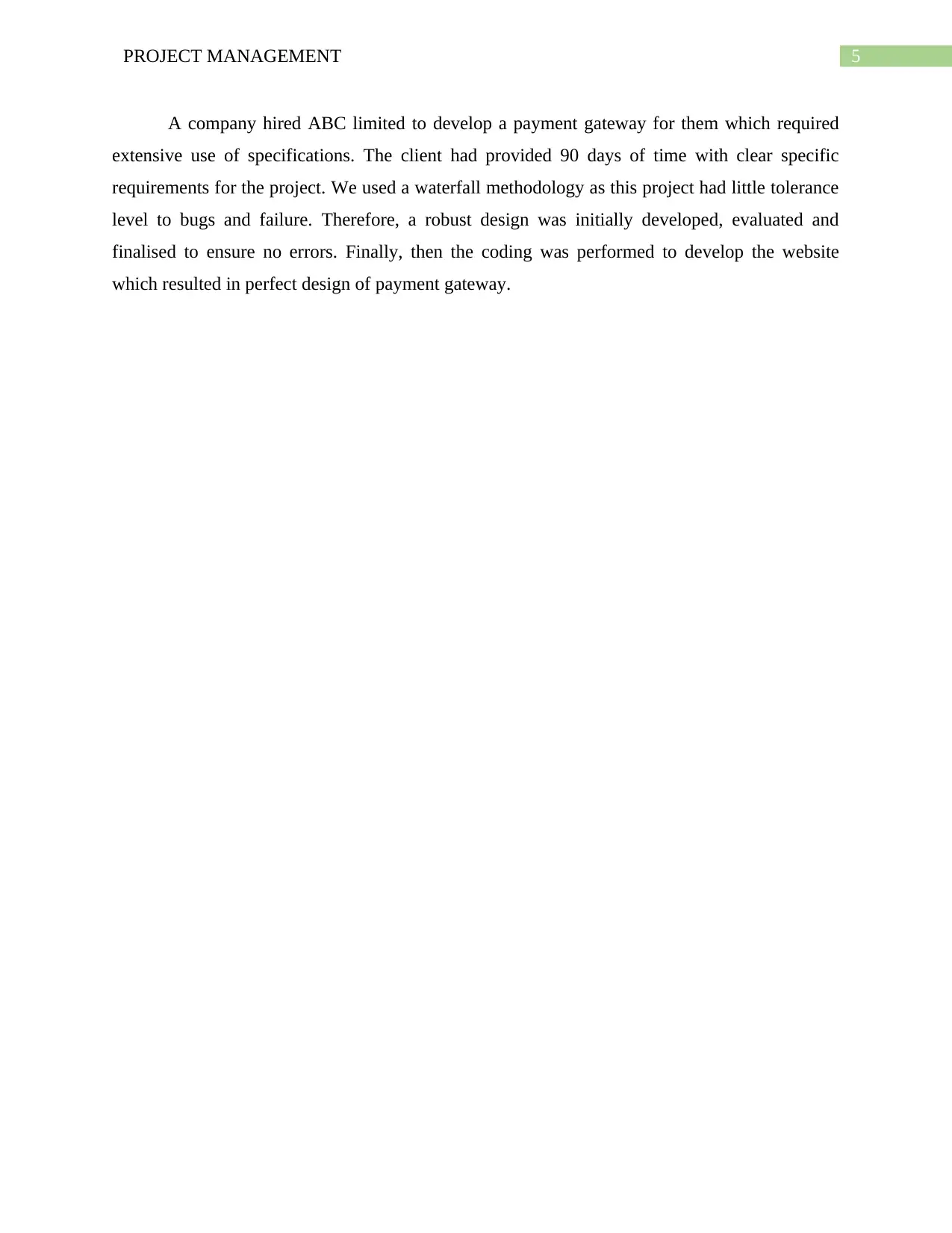
5PROJECT MANAGEMENT
A company hired ABC limited to develop a payment gateway for them which required
extensive use of specifications. The client had provided 90 days of time with clear specific
requirements for the project. We used a waterfall methodology as this project had little tolerance
level to bugs and failure. Therefore, a robust design was initially developed, evaluated and
finalised to ensure no errors. Finally, then the coding was performed to develop the website
which resulted in perfect design of payment gateway.
A company hired ABC limited to develop a payment gateway for them which required
extensive use of specifications. The client had provided 90 days of time with clear specific
requirements for the project. We used a waterfall methodology as this project had little tolerance
level to bugs and failure. Therefore, a robust design was initially developed, evaluated and
finalised to ensure no errors. Finally, then the coding was performed to develop the website
which resulted in perfect design of payment gateway.
⊘ This is a preview!⊘
Do you want full access?
Subscribe today to unlock all pages.

Trusted by 1+ million students worldwide

6PROJECT MANAGEMENT
Paraphrase This Document
Need a fresh take? Get an instant paraphrase of this document with our AI Paraphraser

7PROJECT MANAGEMENT
1 out of 8
Related Documents
Your All-in-One AI-Powered Toolkit for Academic Success.
+13062052269
info@desklib.com
Available 24*7 on WhatsApp / Email
![[object Object]](/_next/static/media/star-bottom.7253800d.svg)
Unlock your academic potential
Copyright © 2020–2025 A2Z Services. All Rights Reserved. Developed and managed by ZUCOL.




